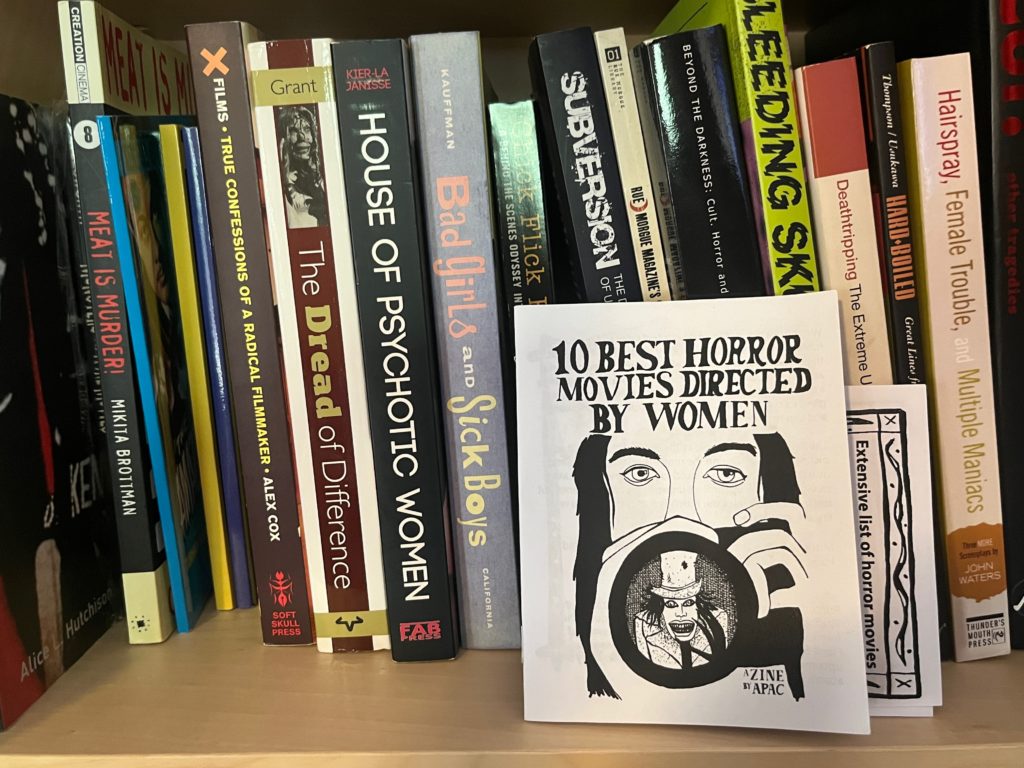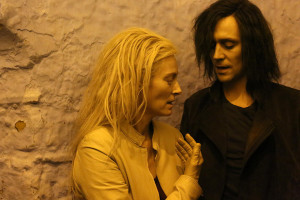I discussed an APac ‘zine back in September, focused on the best revenge movies written by women. The list as a whole didn’t really ring cinematic bells for me, but the inclusion of the, frankly, terrible She-Devil, gave me the opportunity to hold forth on Fay Weldon’s The Lives and Loves of a She-Devil. So it all worked out in the end.
10 Best Horror Movies Directed by Women gives me a lot more to work with, as I’ve seen most of the movies included and one of them is in my own personal top ten list of the best horror movies of all time. However, I need to state again that the ‘zine creator assembled a master list of horror films directed by women so if your own favorites are not on this list, they are likely on the master list, and she worked hard to create a list that features films that hopefully alert the readers to at least a couple that may be new to them.
And I also feel like I should mention that the stylized drawings have an interesting asymmetry to them that adds to the unease most of us enjoy when considering horror films. That may seem like a “faint praise” comment but I often concentrate on talking about text more than visuals so I felt it necessary to say. These APac ‘zines have a very specific and interesting visual appeal.
I won’t spoil the whole list but I will say that I had no idea American Psycho was directed by a woman, and had never heard of the movie, La Captive, directed by Chantal Akerman. It is wholly new to me and I really want to see it now. It looks like I can only see it if I subscribe to the Criterion Collection, and I may just do that.
The movie that impressed me the most with its inclusion is Near Dark, directed by Kathryn Bigelow. It is one of my top ten, top five, actually, horror films. I was in high school when it was released and it was a revelation. Vampire movies covered a lot of cultural ground, to be sure. I was culturally aware of the campy Hammer vampire films but they were not easily available to rent or watch in suburban Dallas in the 1980s. I’d seen plenty of older Bela Lugosi/Lon Chaney vampire films and, of course, the grandfather of them all, Nosferatu. The vampire films that focused on female characters were of the campy sexy Hammer variety or overtly sexy variation on Sheridan LeFanu’s Carmilla story. All of them, even the American films, had a very British and refined air about them. Moody castles, hereditary titles, ancestral wealth – even the excellent The Hunger took place in a rarified place of wealth and privilege in a world foreign to Farmers Branch, Texas.
While I am sure there are films that predated Near Dark that focused on the common person’s experience with vampirism in settings far less luxurious than a well-appointed castle, Near Dark was the first one I ever saw and it was a revelation. Horror films with a democratized setting, like The Texas Chainsaw Massacre, existed, but Sally and Franklin were irritating and the cannibals were… unpleasant, to be sure. Near Dark’s characters were low-brow and decidedly southern, but were also good looking even as they were grubby. Set in Oklahoma, the environment was one I recognized, a place where you might have to worry about a Leatherface with a chainsaw or maybe a creepy serial killer wearing a burlap bag as a mask while brandishing a pitch fork, but not so much vampires. It felt new, adding dimension to old monster legends.
The film features two actors I’ve always had a crush on, Lance Henriksen and the late, great Bill Paxton. The radiant Jenny Wright plays a major role as the love interest, Mae, who turns Caleb, portrayed by a very young Adrian Pasdar, into a vampire. The group of vampires she travels with are none too pleased she foisted Caleb on them but agree to give him a chance. Things do not go as well as one would hope, though Caleb does at times acquit himself well, and the film is filled with blood, gore, fights, and southern charm that clearly inspired the presentation of its spiritual descendant, True Blood.
No spoilers here, friends. The above synopsis is barely a synopsis but if I discuss much more I won’t be able to stop typing. If you haven’t seen this film, you need to, and if you’ve seen it, you need to see it again. But I will direct you to one of the best scenes ever in a vampire film, the prelude to a massacre that should not be this funny but is. Bill Paxton was born to chew this particular scenery.
I know a lot of people consider this a “western” vampire film and they can have their opinions but this is a southern vampire film to anyone who has actually lived in the more western edges of the American South. Lance Henriksen’s character fought in the Civil War on the side of the Confederacy. Characters have southern accents so thick you can cut them with a knife (or extra sharp spurs, as it were). It’s southern to me, and since I’m from the South, I feel comfortable with my assessment.
Overall, I’ve enjoyed the ‘zines I got from APac. I have several others I could potentially discuss for Oddtober, and if I get into a bind and need a quick list to go over, I may well do that. We’ll see. If you would like to get a copy of this ‘zine, you can get one here. The artist, Amèlie Paquet, has a considerable list of interesting horror and feminist ‘zines, so be sure to give her store a look.



